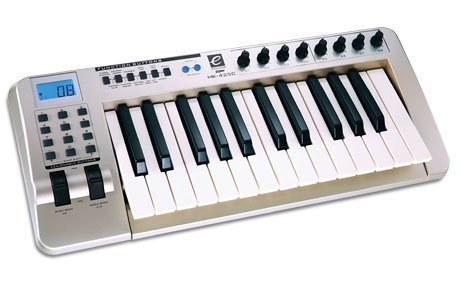
Connecting a
MIDI Keyboard to Laptop PC With a USB
It's easy to
connect a MIDI keyboard to a laptop's USB port.
Musical Instrumental Digital Interface (MIDI) allows
musicians to have an almost unlimited number of "virtual"
musical instruments at their disposal. Using an external
MIDI controller--typically in the form of a piano-like
keyboard--allows users to control and play a MIDI instrument
as if it were a traditional musical instrument. MIDI can
still be used even if you don't have MIDI inputs and outputs
on your PC laptop's sound card, as there are a couple of
ways to connect a PC to a MIDI keyboard using one of the
computer's universal serial bus (USB) ports.

Use a USB
MIDI Controller
1
Purchase a USB MIDI controller keyboard. These controllers
function just like a traditional MIDI controller but connect
directly to your laptop's USB port instead of to MIDI input
and output ports. Some USB MIDI controllers also have
traditional MIDI ports in case you'd like to use the
controller with a different computer with MIDI ports, as
well.
2
Connect your USB MIDI controller's USB output to any USB
port on your laptop using the cable included with your
controller. You'll have to install device drivers for your
computer to recognize and communicate with the keyboard;
this may happen automatically the first time you plug in the
controller, or you may have to install the drivers manually
from a disc included with the controller.
3
Open either your digital audio work station (DAW) with MIDI
instrument plug-ins or a stand-alone MIDI instrument. Play a
note on the USB MIDI controller to ensure that the program
has recognized your device; if it has, a note should sound
out of your computer speakers or monitors. Now you're ready
to start playing.
Use a USB MIDI
Interface
1
Purchase a USB MIDI interface. This is a good option if you
already have a MIDI keyboard that does not have USB
connectivity. These interfaces can be as simple as a cable
with a USB plug on one end and a MIDI plug on the other or
as full-featured as a large device with multiple MIDI and
other inputs.
2
Connect the output of your USB MIDI interface to a USB port
on your laptop using the cable included with your interface.
Use a standard MIDI cable to connect the controller's MIDI
out port to a MIDI in port on your interface. If you're
using a single-cable interface, just connect the MIDI end to
the keyboard's MIDI out port and the USB end to your
laptop's USB port.
3
Load a MIDI instrument, either in a DAW or as a stand-alone
application, on your laptop. Install the USB MIDI
interface's device drivers if this is not done
automatically. A note should sound when you press a key on
your controller. You should now be ready to start playing
your keyboard.
Note: You can
purchase a MIDI to USB connector cable if your keyboard does
not have a USB port and your computer does not have a MIDI
port. These connectors can be expensive but make for easy
connection with little hassle. The other alternative is to
have a MIDI port installed in your computer.


